Plant anatomy, the study of the internal structure of plants, is crucial in understanding plant systematics or taxonomy. Plant anatomy provides important information about the evolutionary relationships and adaptations of plants, which are used to classify and identify them. The present articles discusses the significance of Anatomy in Relation to Taxonomy where we learn the uses of plant anatomy in solving taxonomic disputes.
Learning objectives: Anatomy in Relation to Taxonomy; Importance of Anatomical Characters in Taxonomy; Peculiarities of Anatomical Characters; Anatomical Characters used in Taxonomy/Systematics: Trichomes, Stomata, Leaf anatomy, Nodal anatomy, Stem anatomy; Sclereids and Fibres and Wood Anatomy
Anatomy in Relation to Taxonomy
Ø Anatomical characters are conserved and stable and thus can be used as a “Taxonomic Character” for Plant Systematics of Plant Taxonomy.
Ø Anatomical characters of all the plant parts can be used such as the characters of stem, root, leaves, bark, stomata, trichomes, internal parts etc.
Ø Anatomical features can be used in Taxonomy for:
$. The identification of plants
$. Establishing genetic relationships
$. Solving taxonomic disputes
Peculiarities of Anatomical Characters
Ø The anatomy of the fragmentary materials (such as a piece of wood) can be performed, thus we don’t require the complete portion of the specimen.
Ø Anatomical studies of herbarium specimens can be studied.
Ø High range of anatomical character variability is available among plants.
Ø Most of the anatomical characters are conserved (do not change).
Ø Anatomical characterization can be done without any sophisticated instrumentation.
Anatomical Characters used in Plant Systematics
-
- Trichomes
- Stomata and Epidermal Features
- Leaf anatomy
- Nodal anatomy
- Stem anatomy
- Sclereids and Fibres
- Cambium
- Wood Anatomy
(1). Trichomes
Ø The characters of trichomes are used to compare closely related taxa.
Ø Features of trichomes used: glandular, non-glandular, unicellular, multicellular, shape and size of trichomes etc.
Ø Examples:
$. Non-glandular trichomes: Lauraceae, Moraceae
$. Stellate hairs– Malvaceae
$. Mucilage hairs – Rumex
$. Stinging hairs – Urticaceae
$. Silica hairs – Grasses
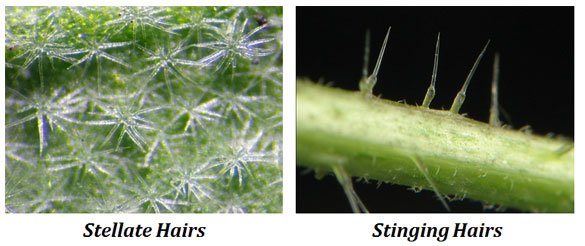
(2). Stomata and Epidermal Features
Ø Features like types of stomata and distribution of stomata are commonly used.
Ø The SEM features of stomata and epidermis are used for comparison.
Ø Some families are specific for their stomata such as:
$. Anomocytic Stomata Ranunculaceae
$. Anisocytic Stomata in Brassicaceae
$. Diacytic Stomata in Caryophyllaceae
$. Paracytic Stomata in Rubiaceae
$. Graminaceous Stomata in Poaceae (dumbbell-shaped guard cells)
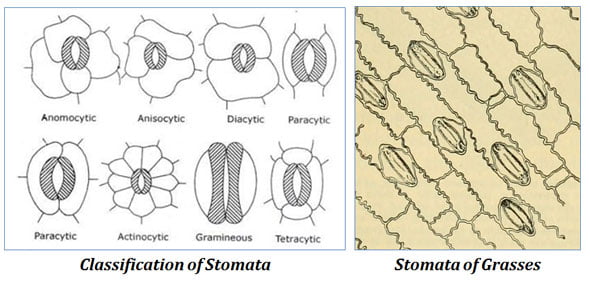
Ø About 35 different types of stomata have been described from vascular plants and most of them can be used as taxonomic evidence.
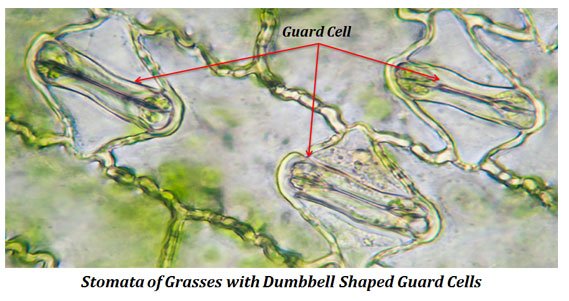
Ø The Sunken stomata in plants indicate its xerophytic habitat.
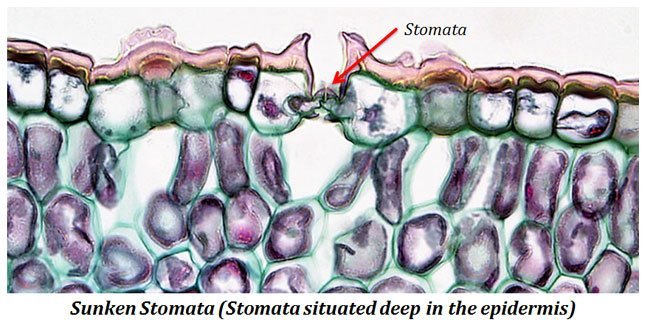
Ø Stomatal Index: The percentage of stomata form to the total number of epidermal cells is called the stomatal index.
Ø Stomatal Index = (S /(S + E)) x 100
Ø Stomatal index can also be used as a criterion for classification and identification of plant groups.
Ø Stomatal distribution on leaves are specific and based on the leaves are classified into Epistomatic leaf (stomata on the upper surface), Hypostomatic leaf (stomata on the lower surface) and Amphistomatic (Stomata on both the surface of the leaf).
Ø Based on development, there are two types of stomata:
(a). Syndetochelic Stomata
(b). Haplochelic Stomata
(a). Syndetochelic Stomata
Ø A type of stoma in which the two guard cells and the subsidiary cells are all derived from a single mother cell.
Ø Syndetochelic stomata are considered as primitive type.
Ø Usually occur in Gymnosperms.
| You may also like NOTES in... | ||
|---|---|---|
| BOTANY | BIOCHEMISTRY | MOL. BIOLOGY |
| ZOOLOGY | MICROBIOLOGY | BIOSTATISTICS |
| ECOLOGY | IMMUNOLOGY | BIOTECHNOLOGY |
| GENETICS | EMBRYOLOGY | PHYSIOLOGY |
| EVOLUTION | BIOPHYSICS | BIOINFORMATICS |
(b). Haplochelic Stomata
Ø A type of stoma in which the two guard cells are derived from a single mother cell and the subsidiary cells are derived from a different initial.
Ø Haplochelic stomata are considered as advanced.
Ø Commonly occurs in Angiosperms.
Ø The developmental pattern of stomata indicates the phylogeny of the plant.
Learn more: Difference between Sydetochielic and Haplochielic Stomata
(3). Leaf Anatomy
Ø Leaf anatomy is extensively used in the systematics of the Cyperaceae family.
Ø Characters leaf anatomy used in plant taxonomy are:
Ø The gross anatomical architecture of the leaf (dicot and monocot).
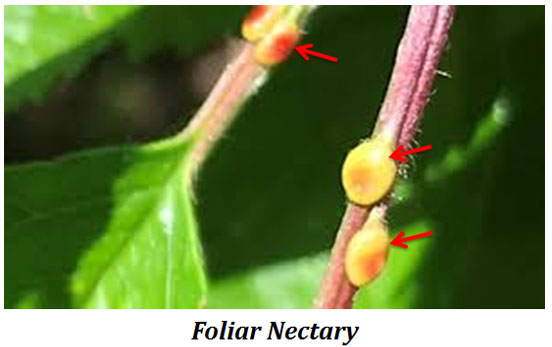
Ø Structural variability: Features of mesophyll, bundle sheath, hydathodes, Kranz anatomy, foliar nectaries and glands, oil glands, stomatal crypts and features of leaf abscission etc.
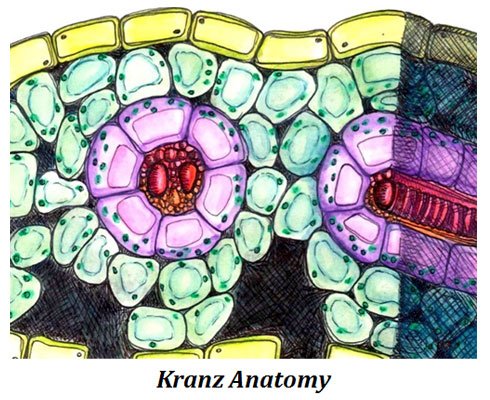
(4). Nodal Anatomy
Ø Three different types of nodes based on anatomical characteristics.
$. Unilacunar node: A node with one lacuna or leaf gap.
$. Three types are found
#. Single leaf trace: Nerium, Calotropis, Lantana
#. Two traces: Clerodendron splendens
#. Three traces: Withania somnifera
$. Trilacunar node:
#. A node with tree lacunae or leaf gaps
#. Example Azadirachta
$. Multilacunar node:
#. A leaf with many lacunae or leaf gaps.
#. Example: Rumex, Polygonum, Aralium
Ø Example: Entire order Centrospermales possess unilacunar node.
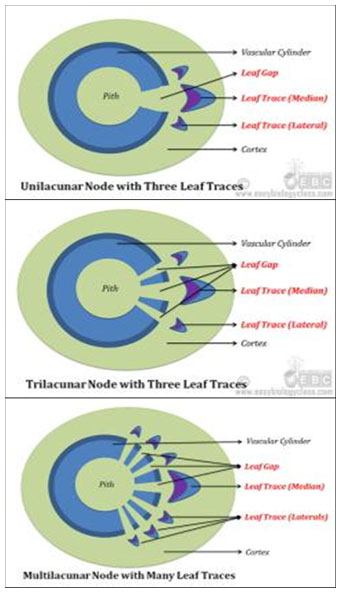
(5). Stem Anatomy
Ø Gross anatomy of dicot and monocot stem can be used in systematics.
Ø The commonly used anatomical criterions of the stem in plant taxonomy are:
Ø Features of epidermis, hypodermis, distributing of collenchyma, sclerenchyma, variations in the endodermis, characteristics of piths, storage region, number – shape and distribution of vascular bundles.
Ø Examples:
$. Biocollateral vascular bundles in Cucurbitaceae.
$. Accessory cortical and medullary bundles in Nyctaginaceae.
$. Anomalous secondary thickening in Bignoniaceae.
$. Included phloem in Amaranthaceae.
$. Anomalous secondary thickening in monocots.
(6). Sclereids
Ø Nature, type and distribution of sclereids and fibres have taxonomic significance.
Ø Example:
$. Monocot fibres are hard fibres (Coir, Musa).
$. Dicot fibres are soft fibres (Jute).
$. Asterosclereids (star-shaped) in Nymphaceae.
$. Trichosclereids: branched hair like (Leaves of Olea).
$. Macrosclereids: Columnar cells (Seed coats of Legumes).
$. Osteosclereids: bone line (Seed coats of Pisum).
$. Reaction wood and distribution of Gelatinous Fibres.
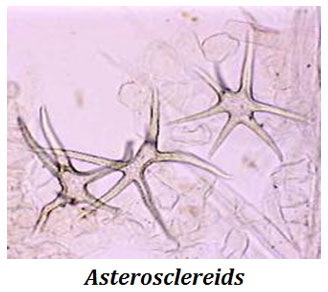
(7). Cambium
Ø Important features of cambium considered for plant systematics are:
Features of cambium
Ø Formation of secondary cambium (normal or accessory, stelar or extrastelar).
Ø Storied vs Nonstoried cambium.
Ø Homogenous vs Heterogenous cambium.
Ø Developmental features of ray and fusiform initials.
(8). Wood Anatomy
Ø Wood anatomy is extensively used in solving taxonomic disputes.
Ø Wood anatomy is also used to detect adulteration in medicinal plants.
Ø Powder microscopy of wood can be used for identification of adulteration.
Ø Colour and odour of wood are characteristic and it can be used for the identification of wood in the timber industry.

Features of Wood used in Systematics
(A). Vessels
(B). Wood Parenchyma
(C). Ray System
(D). Storied structures
(A). Vessels
Ø Features of vessels – distribution pattern, diameter, perforation features, thickening pattern etc.
Ø Solitary vessels are considered primitive than vessels arranged in groups.
Ø Non-porous wood is more primitive than porous wood.
Ø Non-porous wood:- wood of Gymnosperms.
Ø Porous wood:- wood of Angiosperms.
Ø Diffuse-porous wood is primitive than ring porous wood.
(B). Wood Parenchyma
Ø Based on the distribution pattern, two types of wood parenchyma.
(i). Apotracheal type
Ø Here the parenchyma is distributed without any specific relation to the vessels.
Ø Parenchyma is not in direct contact with vessels.
Ø Three different types:
a) Diffuse apotracheal type
b) Banded apotracheal type
c) Terminal apotracheal type
(a). Diffuse apotracheal type
Ø Parenchyma cells occur singly among fibres and tracheids.
Ø Example: Adina cordifolia
(b). Banded apotrachael type
Ø A parenchyma cell occurs in bands.
Ø Example: Pterygota, Lophopetalum
(c). Terminal apotracheal type
Ø Bands of parenchyma cells confined to the ends of growth rings.
Ø Example: Michelia, Acer
(ii). Paratracheal type
Ø Here the parenchyma cells are distributed in close association with vessels.
Ø Two types:
(a). Abaxial type: parenchyma cells found in association with the abaxial surface of vessels (surface away from the centre of the vessels).
(b). Vasicentric type: Parenchyma cells completely surrounded the vessel.
(C). Rays
Ø Features of rays used in systematics and phylogenetics.
Ø Abundance, ray diameter, width and cellular composition.
Ø Degree of wall thickening.
Ø Pitting pattern in ray cells.
Ø Homogenous and heterogeneous ray system.
Ø Heterogeneous rays are considered primitive than homogenous rays.
(4). Storied structures
Ø Storied: The arrangement of cells in horizontal series seen in tangential section.
Ø Storied structures are considered advanced than non-storied cells.
<<< Back to PLANT ANATOMY Notes
| You may also like... | ||
|---|---|---|
| NOTES | QUESTION BANK | COMPETITIVE EXAMS. |
| PPTs | UNIVERSITY EXAMS | DIFFERENCE BETWEEN.. |
| MCQs | PLUS ONE BIOLOGY | NEWS & JOBS |
| MOCK TESTS | PLUS TWO BIOLOGY | PRACTICAL |
